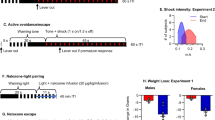Abstract
The effects of morphine pellet implantation and naloxone administration were examined in rats lever pressing under inter-response time schedules of food presentation. Subcutaneous implantation of a morphine pellet initially decreased lever-pressing rates. Tolerance to this effect developed within 3–4 days. Naloxone (0.25–1.0 mg/kg) decreased response rates in morphine-pelleted rats in a dose-dependent and time-dependent manner. All doses of naloxone severely decreased rates of lever pressing on days four to nine post-pellet. This rate-decreasing effect persisted 7–17 days for 0.25 mg/kg naloxone, 9–22 days for 0.50 mg/kg, and 13–28 days for 1.0 mg/kg. Decreases in response rate were due to an increased frequency of long pauses and not to marked shifts in the temporal patterning of those lever presses that did occur. Changes in response rate after naloxone were accompanied by body weight loss. Area values summarizing the naloxone-induced changes in response rate or body weight over time after pellet implantation increased as a function of naloxone dose. Naloxone (0.25–1.0 mg/kg) did not alter performance by placebo-pelleted rats.
Similar content being viewed by others
References
Andrews, H. L., Himmelsbach, C. K.: Relation of the intensity of the morphine abstinence syndrome to dosage. J. Pharmacol. Exp. Ther. 81, 288–293 (1944)
Babbini, M., Gaiardi, M., Bartoletti, M.: Changes in operant behavior as an index of a withdrawal state from morphine in rats. Psychon. Sci. 29, 142–144 (1972)
Babbini, M., Gaiardi, M., Bartoletti, M.: Changes in fixed-interval behavior during chronic morphine treatment and morphine abstinence in rats. Psychopharmacologia (Berlin) 45, 255–259 (1976)
Bläsig, J., Herz, A., Reinhold, K., Zieglgänsberger, S.: Development of physical dependence on morphine in respect to time and dosage and quantification of the precipitated withdrawal syndrome in rats. Psychopharmacologia (Berlin) 33, 19–38 (1973)
Cicero, T. J., Meyer, E. R.: Morphine pellet implantation in rats: quantitative assessment of tolerance and dependence. J. Pharmacol. Exp. Ther. 184, 404–408 (1973)
Djahanguiri, B., Richelle, M., Fontaine, O.: Behavioral effects of a prolonged treatment with small doses of morphine in cats. Psychopharmacologia (Berlin) 9, 363–372 (1966)
Downs, D. A., Woods, J. H.: Morphine, pentazocine and naloxone effects on responding under a multiple schedule of reinforcement in rhesus monkeys and pigeons. J. Pharmacol. Exp. Ther. 196, 298–306 (1976)
Ford, R. D., Balster, R. L.: Schedule-controlled behavior in the morphine-dependent rat. Pharmacol. Biochem. Behav. 4, 569–573 (1976)
Gellert, V. F., Sparber, S. B.: A comparison of the effects of naloxone upon body weight loss and suppression of fixed-ratio operant behavior in morphine-dependent rats. J. Pharmacol. Exp. Ther. 201, 44–54 (1977)
Gibson, R. D., Tinstad, J. E.: Formulation of a morphineimplantation pellet suitable for tolerance-physical dependence studies in mice. J. Pharm. Sci. 59, 426–427 (1970)
Goldberg, S. R., Morse, W. H., Goldberg, D. M.: Some behavioral effects of morphine, naloxone and nalorphine in the squirrel monkey and the pigeon. J. Pharmacol. Exp. Ther. 196, 625–636 (1976)
Goldberg, S. R., Schuster, C. R.: Conditioned suppression by a stimulus associated with nalorphine in morphine-dependent monkeys. J. Exp. Anal. Behav. 10, 235–242 (1967)
Goldberg, S. R., Schuster, C. R.: Nalorphine: Increased sensitivity of monkeys formerly dependent on morphine. Science 166, 1548–1549 (1969)
Goldberg, S. R., Schuster, C. R.: Conditioned nalorphine-induced abstinence changes: Persistence in post morphine-dependent monkeys. J. Exp. Anal. Behav. 14, 33–46 (1970)
Goldberg, S. R., Woods, J. H., Schuster, C. R.: Nalorphine-induced changes in morphine self-administration in rhesus monkeys. J. Pharmacol. Exp. Ther. 176, 464–471 (1971)
Heifetz, S. A., McMillan, D. E.: Development of behavioral tolerance to morphine and methadone using the schedule-controlled behavior of the pigeon. Psychopharmacologia (Berlin) 19, 40–52 (1971)
Holtzman, S. G., Villarreal, J. E.: Operant behavior in the morphine-dependent rhesus monkey. J. Pharmacol. Exp. Ther. 184, 528–541 (1973)
Manning, F. J., Jackson, M. C.: Enduring effects of morphine pellets revealed by conditioned taste aversion. Psychopharmacology 51, 279–283 (1977)
McMillan, D. E.: Effects of narcotics and narcotic antagonists on operant behavior. In: Narcotic Antagonists: Advances in Biochemical Psychopharmacology, vol. 8, M. C. Braude, L. S. Harris, E. L. May, J. P. Smith, and J. E. Villarreal, eds., pp. 345–359. New York: Raven Press 1974
McMillan, D. E., Dewey, W. L., Harris, L. S.: Characteristics of tetrahydrocannabinol tolerance. Annals N.Y. Acad. Sci. 191, 83–96 (1971)
McMillan, D. E., Wolf, P. S., Carchman, R. A.: Antagonism of the behavioral effects of morphine and methadone by narcotic antagonists in the pigeon. J. Pharmacol. Exp. Ther. 175, 443–458 (1970)
Ponicki, E.: A simple technique for auto-shaping lever pressing by the rat within a single session. Psychol. Rec. 24, 119–122 (1974)
Thompson, T., Grabowski, J. G.: Reinforcement schedules and multioperant behavior repetoires. New York: Appleton-Century-Crofts 1972
Way, E. L., Loh, H. H., Shen, F.: Simultaneous quantitative assessment of morphine tolerance and physical dependence. J. Pharmacol. Exp. Ther. 167, 1–8 (1969)
Wei, E.: Assessment of precipitated abstinence in morphine-dependent rats. Psychopharmacologia (Berlin) 28, 35–44 (1973)
Wei, E., Loh, H. H., Way, E. L.: Quantitative aspects of precipitated abstinence in morphine-dependent rats. J. Pharmacol. Exp. Ther. 184, 398–403 (1973)
Winter, C. A., Flataker, L.: Studies on hepatazone (6-morpholino-4,4-diphenyl-3-hepatanone hydrochloride) in comparison with other analgesic drugs. J. Pharmacol. Exp. Ther. 98, 305–317 (1950)
Young, A. M., Thompson, T.: Effects of naloxone on schedule-controlled behavior in morphine-maintained pigeons. J. Pharmacol. Exp. Ther. 205, 236–245 (1978)
Author information
Authors and Affiliations
Rights and permissions
About this article
Cite this article
Young, A.M., Thompson, T. Naloxone effects on schedule-controlled behavior in morphine-pelleted rats. Psychopharmacology 62, 307–314 (1979). https://doi.org/10.1007/BF00431963
Received:
Accepted:
Issue Date:
DOI: https://doi.org/10.1007/BF00431963




